To comment please open your gmail account or use my email address, FB or Messenger. Scroll down for other comments.
 |
| Jacinta and Francisco (now canonised) and their cousin Lucy |
Overseas, in countries not beleagured like New Zealand by modernist cardinals and bishops, the feast of Our Lady of Fatima today (their time) is being celebrated by processions, Benedictions, Adoration of the Eucharist and public recitation of the Holy Rosary.
It seems fitting to honour the feast, for countries where they hold Our Lady of Fatima dear, by producing this article by Marian T Horvat PhD, on the phenomenon of The Two Sister Lucys alluded to on this blog yesterday - if only to confound the sceptics like 'im indoors.
Of course not only that, but to show the reasons for the real Sister Lucy's disappearance and understand how it reflects profoundly on the post-Vatican II Church - and the Novus Ordo effect.
The Two Sister Lucys
Photos and Facts
Marian T. Horvat, Ph.D.
| I was invited by the Editor of the TIA (Tradition in Action) website, Atila Guimarães, to write more about the possibility of having not one, but two Sister Lucys. I had no idea that raising the possibility of having two Sister Lucys would ignite the huge controversy that is still spreading like wildfire. Independent of any other conclusion, this simple fact seems to show how many Catholics are suspicious of whatever comes from the top regarding Fatima. For them, Fatima is not a finished story, as some ecclesiastical authorities have pretended. It is still alive, very much alive. This controversy brought many new plates to the table: historical data that had been forgotten regarding Sister Lucy, observations about her features and psychology, as well as many photos I have separated six sets of pictures of Sister Lucy. In the comparisons, I tried to find similar positions and states of spirit in both the young Sister Lucy and the older one in order to validly support this assessment: they seem to be different persons. As in my previous article, for the sake of convenience, I will call the person in the set of earlier photos Sister Lucy I, and the older person Sister Lucy II. 1. The slightly smiling Sister Lucys
The close-up of Sister Lucy II, also slightly smiling, is a photo dated May 13, 1982, so she would be age 75. There are many points of difference in the features that indicate to me we are looking at two different people.
The eyebrows of Sister Lucy II, partially concealed by the dark frames of her glasses, are not straight, but slightly arched and taper off; the arch begins directly over the eye. There is a broad space without brows above the nose between the two eyebrows. • Some readers objected that eyebrows thin with age on some people, which would explain the clear difference between the brows. I don’t believe this is necessarily so. Even if this were admitted, without surgery or some artificial means, the shape of the one’s brows does not change from a straight line to an arched one, because the shape of the brows follow the shape of the bone structure of the forehead. • Regarding the focus of the eyes of Sister Lucy I, they seem normal with a small tendency toward extropia, or divergent strabismus, that is, the eyes slightly drift outward. However, the eyes of Sister Lucy II clearly suffer from esotropia, or convergent strabismus, that is, the eyes strongly turn in toward the nose.
Although the cheeks of Sister Lucy II are partially covered by her large glasses, it seems clear she lacks these bulges. • I could not find any photo of Sister Lucy I, smiling or serious, with her nostrils open. They do not flare naturally. All the photos of Sister II, however, show her with her nostrils flaring. They open naturally.
But, the cheeks of Sister Lucy II are flat and broad, with no creases or dimples when she smiles. • In his description of Sister Lucy, Walsh also notes her protruding upper lip and “heavy lower one” that hangs. The two lips have different widths. The lips of Sister Lucy II, however, are flat, thin, tight and of an equal width. • Objectors argued that a possible denture would explain the different teeth of the two Lucys. I will treat the teeth as a special topic below in set 4. Here I will simply discuss the effect of the teeth on the lips of these two photos. If a person has large lips to cover long teeth, as Sister Lucy I evidently had when she was young, then if someone replaced her long teeth with short ones, the lips of this person should easily cover these now much-smaller teeth. So, we should have photos of an older Sister Lucy with lips more than sufficient to cover her smaller teeth. But the opposite happens. Sister Lucy II’s lips do not normally cover her much smaller teeth. • When Sister Lucy I smiles, the ends of her mouth point upward. But when Sister Lucy II smiles, the ends of her mouth point downward.
• Sister Lucy I’s chin is strong but not salient. On the contrary, the chin of Sister Lucy II is a prominent chin. The latter has a square jaw, which does not appear in the photos of Sister Lucy I. 2. The profiles of the two Lucys
Sister Lucia II is seated next to the tomb of Francisco at Fatima on May 13, 2000. Their heads are in very similar positions, they are staring straight forward, and both have expressions of meditation or prayer.
However, the nose of Sister Lucy II is rounded at the tip, pointing slightly downward. The different shapes of the noses can be measured by the angle formed by the intercession of the line of the nose with the space above the upper lip. In Sister Lucy I the angle formed by these lines is an obtuse angle. On the contrary, the angle of these lines in Sister Lucy II is an acute angle. • One can also note in this profile close-up of Sister Lucy II how arched the brows are, confirming the previous observations.
However, the chin of Sister Lucy II, although she is older and heavier, juts forward and outward. It is so prominent that it forms a kind of platform extending out further than her nose. It is “lantern-shaped,” as one of my readers so aptly described it 3. The large smile of the Lucys
• Even when she smiles broadly, the lower lip of Sister Lucy I is thick, heavy and still a bit slack. When Sister Lucy II smiles, her lower lip is thin and tight. • The dimple and creases of Sister Lucy I appear again in this smile. But they are completely missing on the smooth cheeks of Sister Lucy II. • The nose of Sister Lucy II has marked nostrils that do not show on Sister Lucy I’s nose. • The round tip of Sister Lucy II’s nose extends downward. But the angular tip of Sister Lucy I’s nose extends upward. • The teeth of Sister Lucy I are clearly different, but since many readers pointed out the possibility that dentures would explain these differences, I will discuss this below in set 4 of photos.
4. Sister Lucy’s teeth The objections raised by readers about the bad teeth of Sister Lucy I (photo 3, above) and the blatantly different teeth of Sister Lucy II can be summarized in two arguments as follows: First argument: Sister Lucy I has very long and bad teeth. This would make her a candidate for dentures. Now then, dentures can change the mouth structure. Therefore, all the changes of her face can be explained by the extraction of all her teeth and the use of dentures. Second argument: in the photos of Sister Lucy II, she would appear to be wearing a set of dentures, even though they are small teeth. Therefore, the conclusion of the first argument is confirmed. Regarding the first argument, I agree with its first premise, that is, Sister Lucy I had bad teeth and was a candidate for dentures. But its second premise – dentures change the structure of the face of a person – is open to dispute. I looked at many before-and-after pictures of persons who had full mouth reconstruction dentures, and did not notice any significant structural change in the smile or face. From what I have read, only cheap and badly constructed dentures show short teeth and too much gum. However, it is difficult to imagine that the prestigious Carmel of Coimbra, to which Sister Lucy I was transferred with her bad teeth, would contract an incompetent dentist to change the teeth of a person so important to the Catholic world as Sister Lucy. It is much more probable that the dentist was good, the dentures of good quality, and that they would not have significantly changed her smile or face. Regarding the conclusion – all the differences we see in the two collections of photos would be explained by the dentures – I clearly disagree with this. How can false teeth change the shape of the nose, the eyebrows or the bone of the chin? Only a complete plastic surgery could explain such differences.
• No one replaces bad and ugly teeth by another set of bad and ugly teeth. Indeed, why would a competent dentist build dentures with an ugly ¼” gum appearing on a person who is often smiling? (see photos 4c and 4d) Why did he choose to set such short, ugly teeth for such a prominent person destined to play a public role? Professionally speaking, it is highly unlikely he would have made such a set of teeth. That is, ugly teeth more likely suggest natural teeth, not dentures • In addition, since dentures are artificial, they never change their appearance. But at times Sister Lucy II's gums seem inflamed, covering one tooth (see arrow in photo 4a), as a reader pointed out; at times her gums seem to retract making some teeth appear longer as in photo 4b. • So, rather than dentures we could well be looking at the natural teeth of Sister Lucy II. Therefore, neither the premise nor the conclusion of the second argument is secure. Whether Sister Lucy II is wearing dentures is open to discussion, as far as observation of photos goes. And if these are the natural teeth of Sister Lucy II, then they are clearly different from the natural teeth of Sister Lucy I. In that case, how can it be explained except that we are looking at two different persons? 5. The two Sister Lucys in a serious attitude
It is not so easy to find a picture of Sister Lucy II with a serious expression. Even when she is not smiling, her face lacks the swarthy tonus and brooding look of Sister Lucy I. Photo 5 of Sister Lucy II, in which she appears serious, is from the cover of the 2004 edition of Fatima in Lucia's Own Words.
• The slight divergent strabismus can again be noted in the eyes of Sister Lucy I. On the contrary, a strong convergent strabismus is apparent in the eyes of Sister Lucy II.
• The two creases in the cheeks of Sister Lucy I that extend down past her mouth form two very straight lines. But the cheek creases of Sister Lucy II form arches. • Under the lower lip of Sister Lucy I there is a concave shadowed area. In it the contours of the muscle in her mid-chin can be noticed. However, there is no concave space under the lower lip of Sister Lucy II, nor protrusions of any kind on the chin, even though one might expect this kind of defect to intensify rather than disappear with age. • Sister Lucy II seems to have lost the strong peasant-like rude features and skin of Sister Lucy I and taken on a much clearer skin tone, indicating to me a person of a different social background. • Admitting this change of skin tone, some readers argued that it could be explained by age, which makes the skin flaccid and clearer. Therefore, they argued, this would give the impression of a person of different nationality or social level.
Also, Lucy’s mother, at the right of the old women, who probably is in her 50s, does not show any tendency to have a different skin tone. 6. The space above the lip
In this space we also note a defined vertical groove, the philtrum, in the center.
7. The gestures and spirit The last two sets of pictures present six photos each of Sister Lucy I and Sister Lucy II in various poses. Most of the photos of Sister Lucy I are dated 1946. The photos of Sister Lucy II are from her May 2000 visit to Fatima.
From her postures, gestures and expression, it is easy to believe that she is the person who saw Our Lady and understood the gravity of the message and the role she should play in it. Her expression also fits with a person who saw Hell as she did on July 13, 1917. She had maintained this same state of soul at least up until December 26, 1957 when Fr. Augustin Fuentes had an interview with her. Fr. Fuentes was the official Fatima archivist at the time and confidante of Sister Lucy. At that interview, he confirmed that she appeared quite serious and “very sad.” He said she expressed great concern that “no one – neither the good nor the bad – was paying any attention to the Holy Virgin’s message.” She was also very worried about the revelation of the Third Secret, and stressed once again that a great chastisement would come for the world, where nations would disappear, if mankind remained oblivious to Our Lady’s message and Russia did not convert. What was coming, she warned, was a decisive battle between the Devil and the Blessed Virgin, where souls of the faithful would be abandoned by the religious authorities. She told him, "Father, we should not wait for an appeal to the world to come from Rome on the part of the Holy Father, to do penance. Nor should we wait for the call to penance to come from our Bishops in our diocese, nor from the religious congregations" (emphasis added). Each person would have to save his own soul, relying on the Rosary and devotion to the Immaculate Heart of Mary. She was also worried because the Holy Father and the Bishop of Fatima, the only ones permitted to know the Secret, “have chosen to not know it so that they would not be influenced by it.” [for the complete text of the interview, click here] These most grave concerns were reflected in her expression and general demeanor.
She has lost the natural timidity typical of Sister Lucy I; she became not only fearless but also completely comfortable and integrated in ambiences external to her contemplative life. In photos 13 and 14, a friend has his arm around her, a protective gesture she accepts without reservation. In a tête-à-tête with John Paul II (photo 11), she leans forward, her face smiling and jovial. She no longer seems anxious about the future, her mission, a coming chastisement, the corruption of consecrated souls, or the many other concerns she had before. She seems optimistic and content. 8. Acceptance of a different doctrine
If Our Lord and Our Lady continued to appear to her, why did she say nothing about Vatican II and the so-called reforms that came from it, such as the Novus Ordo Mass, other liturgical novelties, and the loss of religious vocations? On the contrary, Sister Lucy II appears completely adapted to these novelties; for example, in the photos at right, she is receiving Communion standing on May 13, 1991 (top) and on May 13, 2000 (bottom). If she expressed such serious concern about the importance that the Third Secret be revealed in 1960, why was she silent about it for the next 40 years? Contradicting what she had previously stated, how could she confirm the supposed secret that was unveiled by the Vatican in 2000, along with an “official interpretation” by Cardinal Ratzinger and Archbishop Tarcisio Bertone who then declared the Fatima episode closed, “a part of the past” ? These, and many other questions, could be explained by the fact that there was a different Sister Lucy being presented to the public after 1960. I have pointed out the differences not only between the faces of Sister Lucy I and Sister Lucy II, but also in their spirits and attitudes. I present them to my readers with the honest concern to expose the truth so that Catholics may judge whether they are being fooled or not. Immaculate Heart of Mary, pray for us now and at the hour of our death. |
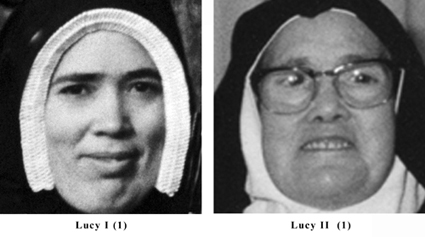




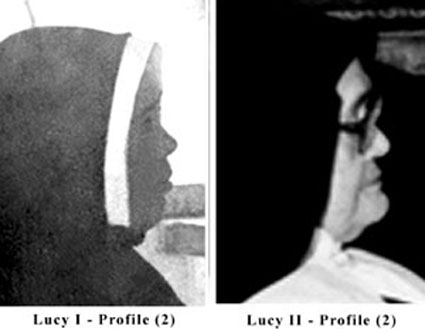
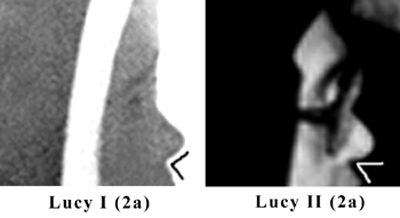
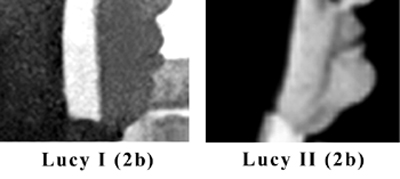
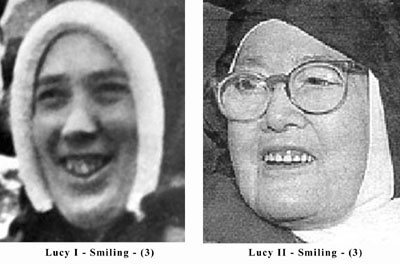



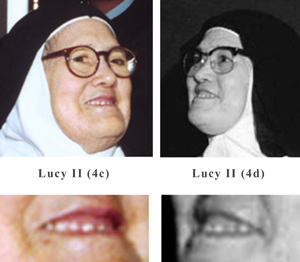
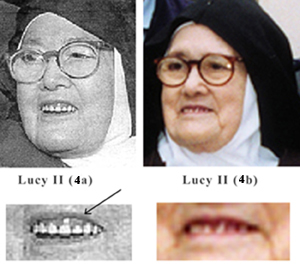
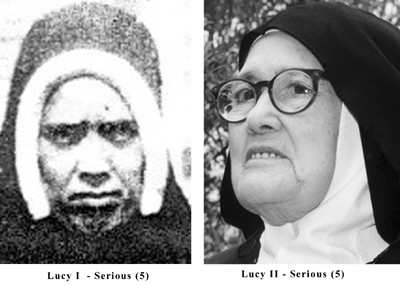
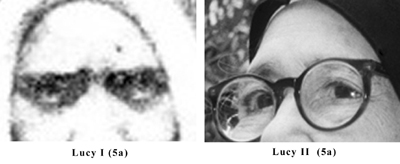
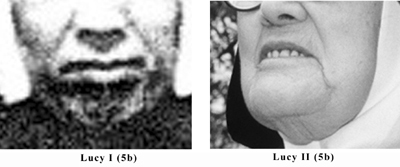
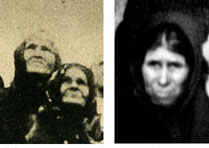
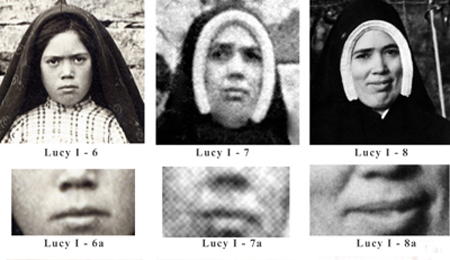
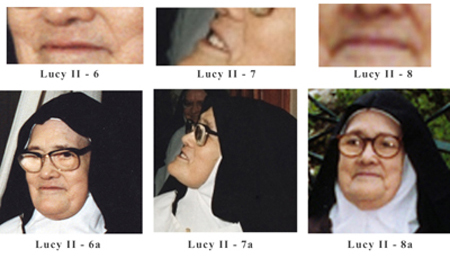
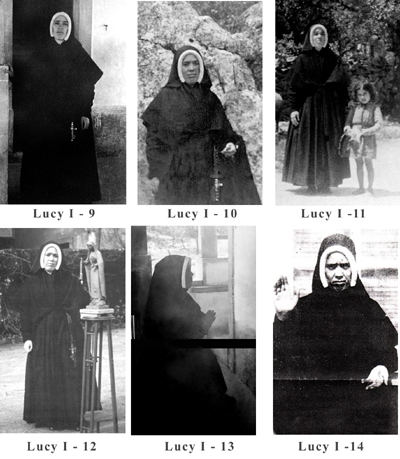
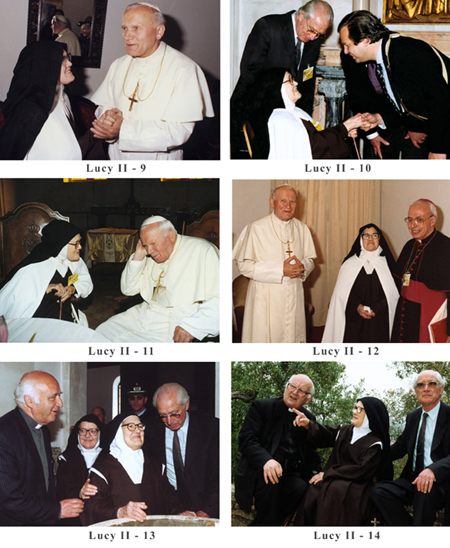
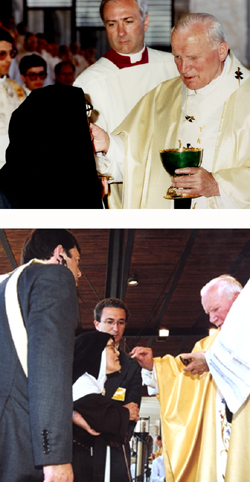
This comment has been removed by the author.
ReplyDeleteThere was a theory of two Pope Paul Vii's. It was disproved from memory. It was publicised by Veronica Luken of Bayside. A false visionary.
ReplyDeleteTheresa Rogers:
ReplyDeleteAgree. Also, there are some photos floating around where they have shown the natural aging of the real Lucy’s face with forensic science. And it would have looked very different to Lucy Mk II.
I say:
DeleteI tried to copy and paste your photos Theresa, and was promptly shut out of my own blog by Google Chrome with warnings of phishing.
Theresa Rogers:
DeleteSomeone doesn’t like you in internet world.
Tom Brown says:
DeleteBeware Jack the Lad.
Or Jack the lass��...
DeleteTheresa Rogers adds:
ReplyDeleteHere’s the forensic article with photo
https://www.traditioninaction.org/polemics/F_03_Lucy14.html
I think there is little doubt that an impostor played the role of Sister Lucy in those latter years. This could not have feasibly happened without the knowledge, probably collusion, of the Vatican.
ReplyDeleteMy question then is: "Why ?"
So the {false} Sr Lucy became a mouth piece for modernist Rome.
ReplyDelete